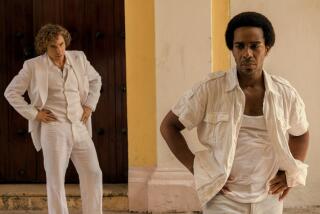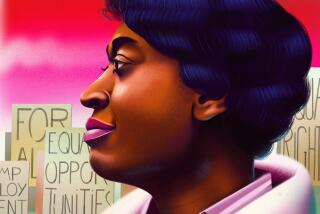‘Black Against Empire’ tells the history of Black Panthers
Black Against EmpireThe History and Politics of the Black Panther Party
Joshua Bloom and Waldo E. Martin Jr.University of California Press: 560 pp., $34.95
The defenders of the 2nd Amendment once had a powerful ally in America: the Black Panthers. The self-styled revolutionaries believed there’s something powerful and liberating about holding a firearm in your hands.
In “Black Against Empire: The History and Politics of the Black Panther Party,” we learn that Huey Newton and Bobby Seale felt lots of gun love as they drove up and down the streets of Oakland in 1966. Back then, it was legal for California residents to carry firearms in public — as long as said weapons were held in full view.
So Newton and Seale patrolled ghetto streets armed with rifles, shotguns and copies of California’s liberal gun laws. To fight police brutality, they policed the cops. Time and again, their standoffs with officers ended with Newton and Seale giving lectures on the law.
“What’s the matter with you?” Newton told one officer. “You’re supposed to be people enforcing the law, and here you are, ready to violate my constitutional rights.... You can’t have my gun. The only way you’re gonna get it from me is to try and take it.”
For a few surreal months, the newly formed Black Panther Party challenged the police again and again without a single shot being fired. These episodes make for some of the most compelling reading in “Black Against Empire,” the authoritative if flawed new history of the Panthers by Joshua Bloom and Waldo E. Martin Jr., drawing heavily on the Panthers’ extensive archives.
Of course, “the man” quickly grew “hip,” as they might have said back then, to the Panthers’ tactics. California state legislators soon proposed a bill, the Mulford Act, that made it illegal to carry firearms in public. When the Panthers entered the state Capitol for a news conference carrying shotguns, it only greased the legislative wheels: Gov. Ronald Reagan quickly signed the bill into law.
The Black Panthers were born of a world turned upside down. America was at war in Vietnam — but American cities burned too, and American soldiers were deployed to keep the peace at home. Bloom and Martin illustrate, convincingly, how the Black Panthers rose from this social and political maelstrom.
In 1967, the mostly Southern-led civil rights movement of Martin Luther King Jr. had just achieved its greatest legislative victories. But cities like Oakland, Los Angeles and Detroit seethed with injustice, much of it inflicted by white-dominated police departments on minority communities.
Between 1968 and 1970 the Black Panthers tapped into African American anger more effectively than any other group, Bloom and Martin argue. Many of its leaders were certified street brawlers, born in the South but raised in Northern and Western cities. As hardened, supremely articulate and self-appointed revolutionaries, they crafted a unique brand of Afrocentric, hyper-masculine resistance to the status quo.
One iconic image captured this spirit more than any other: It shows a bereted Newton as “minister of defense,” seated on a wicker chair while holding a rifle and a spear. (The photograph was taken, we learn in “Black Against Empire,” by a sympathetic white photographer.) The Panthers were savvy marketers, and they placed a large poster featuring the picture in each of their offices.
The image announced “to the world that the vanguard of Black Power had arrived,” with Newton as the “leader and defender of the black colony in the white motherland America,” write Bloom and Martin, a sociologist and historian, respectively, both based at UCLA.
A largely academic book, “Black Against Empire” spends many pages documenting the group’s city-by-city spread across the U.S. As a piece of writing, it’s most lively when Bloom and Martin give us fleeting depictions of the bravado and the theatricality with which the Panthers won over legions of followers.
Consider, for example, the 1968 speech “minister of information” Eldridge Cleaver delivered in a Bay Area park to accept the Peace and Freedom Party’s nomination for president.
“I would love to sit around ... drinking wine, smoking pot and making love to my wife, but I can’t afford to be doing that while all these pigs are loose,” Cleaver says. “Here I am, a convict. A whole lot of respectable people nominated me for president. I’m not going to get elected.... I’m a symbol of dissent, or rejection.”
There have been at least a half dozen books and films by former Panthers, or about them, over the last decade. “Black Against Empire,” however, is unique among them in the scope and depth of its scholarship.
For deeper psychological insight into the Panthers leadership, however, you’ll have to read other books — Elaine Brown’s excellent 1992 memoir “A Taste of Power” comes to mind. Men with personalities as big and brazen as those of Seale and Cleaver deserve a thorough character study: Unfortunately, there isn’t much nuance to the portrayal of those men in “Black Against Empire.”
Instead, Bloom and Martin give us Panthers leaders who are, for the most part, idealists without noticeable flaws. That points to the most dramatic failing in “Black Against Empire” — the authors’ lack of critical distance from their subjects. Too much of the analysis in “Black Against Empire” is written in the romantic rhetoric of a bygone era of American radical discourse. Many passages read as if they were written in the pages of the Panthers’ official publication, “The Black Panther,” circa 1970.
The authors describe King as a faded “insurgent,” a label he most certainly would have rejected. And when a wave of urban conflagrations helps fill the Panthers’ ranks, Bloom and Martin describe the political moment thusly: “In the summer of 1967, the floodgates lifted, and the dream of black nationhood poured through the channels of urban rebellion.”
In the end, however, Bloom and Martin offer a balanced assessment of why the Panthers movement began to fade quickly after 1970.
It wasn’t just J. Edgar Hoover, the FBI and assorted police forces that undermined the Panthers — though reams of newly released documents offer ample proof of the effective work of police-hired provocateurs. Factionalism, “adventurism” and “criminal activity” also undid the movement.
Above all, the Black Panthers quickly unraveled because the country itself changed so quickly, Bloom and Martin write. With the Vietnam War winding down, and the War on Poverty and affirmative action ramping up, the Panthers’ confrontational style started to wear thin.
“The political ‘system’ had been inoculated against the Panthers’ politics,” Bloom and Martin write.
The most important contribution of “Black Against Empire” is simply to treat the Black Panthers as the serious political and cultural force they were. It was a movement of intelligent, explosive dreamers who believed that to die for their cause (as many did) was to become “heavier than a mountain.”
More to Read
Sign up for our Book Club newsletter
Get the latest news, events and more from the Los Angeles Times Book Club, and help us get L.A. reading and talking.
You may occasionally receive promotional content from the Los Angeles Times.








